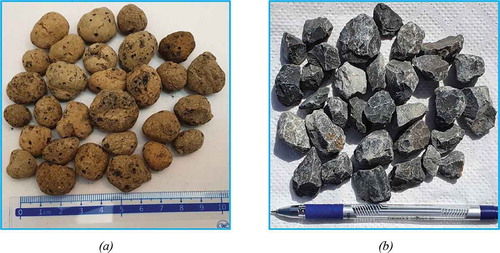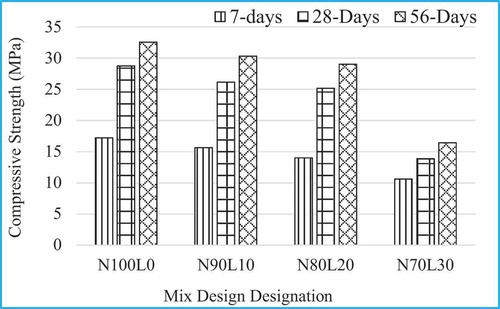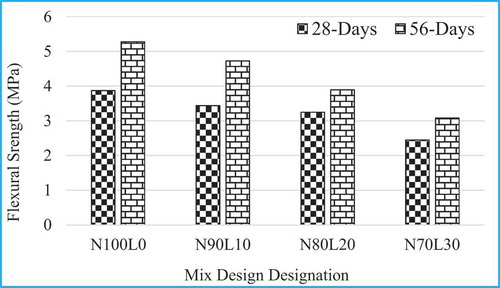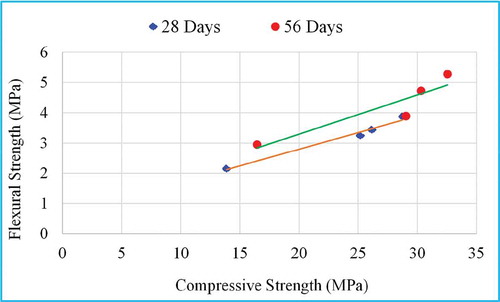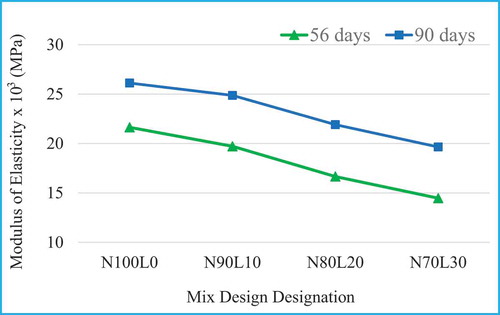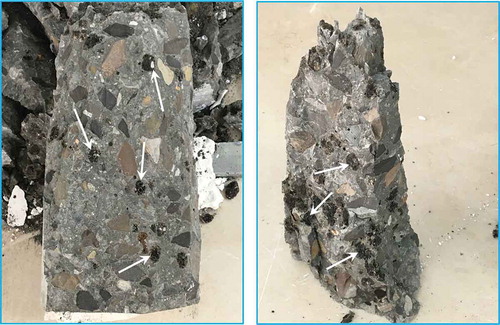Abstract
Lightweight aggregate concrete mixtures incorporating 0, 10, 20, and 30 weight percent replacement of normal-weight aggregate with lightweight aggregate and crushed stone as fine aggregate were tested at 7, 28, 56, and 90 days for various strength and durability characteristics of hardened concrete. Test results indicated that compressive, flexural, and split tensile strengths and static modulus of elasticity of concrete mixtures reduced with an increase in the percent replacement of normal-weight aggregate with lightweight aggregate. Furthermore, the volume of permeable voids and hence moisture sorption in lightweight aggregate concrete reduced as the lightweight aggregate content was increased pointing at the enhanced durability of the lightweight aggregate concrete mixtures. A significant reduction in dry density of hardened concrete was recorded due to the inclusion of lightweight aggregate in concrete mixtures. Considering the strength and reduction in dry mass, 20 wt.% replacement of normal-weight aggregate with lightweight aggregate is considered to be an optimum level. Reduced density of lightweight aggregate concrete mixtures is viewed as a major source of economical design of structural members as the lower concrete density will result into a reduction of self-weight of the structural members, which will allow the economical structural design of such members with smaller cross-sections. Test results of this work also showed the viability of 100% replacement of desert sand with crushed stone sand as fine aggregate towards the production of lightweight aggregate concrete.
PUBLIC INTEREST STATEMENT
Reduction in self-weight of reinforced concrete structural members, which form part of the frame of a built infrastructure, is key to the design of such structures economically. Since concrete comprises about 70% of aggregate (by volume), the use of aggregate having lower density as compared to that of the normal aggregate in concrete shall serve this purpose.
In this paper, the use of lightweight aggregate as partial replacement of normal aggregate for production of structural grade concrete was investigated. Test results showed the viability of the practice as the resulting concrete had the desired strength and durability characteristics but with significantly reduced density in fresh and hardened state.
If implemented commercially, the practice is expected to contribute to the construction of an economical built-infrastructure with enhanced service life.
1. Introduction
The leading factor affecting the choice of construction material in the current era is its satisfactory performance viz-a-viz climate change and sustainability (CitationMehta, CitationMehta 1). The performance of structural members is subjected to periodic testing in severe weather conditions caused by environmental changes. Since these members are subjected to heavy loads at the same time, the useful service life of structural members is, therefore, determined by their ability to resist environmental as well as structural loads (Mehta & Monterio, Citation2016). Concrete has been the most popular construction material for a long time (Mehta & Monterio, Citation2016; Mindess et al., Citation2003). This popularity is brought about by its excellent resistance to environmental effects, proper loading carrying capacity, long service life, and ease of production. If a concrete with smaller unit weight is manufactured, it will enhance its strength to weight ratio making it more valuable structural material. Since aggregate constitute about 70% (by volume) of concrete, the use of aggregate having lower unit weight shall result in the production of concrete having a low density in a fresh and hardened state (Mehta & Monterio, Citation2016; Mindess et al., Citation2003). ACI committee 213 and ASTM C330 lists various types of aggregate and their density and strength requirements that can be used as lightweight aggregate (LWA) depending on the choice of the resulting concrete called lightweight aggregate concrete (LWAC) (213, A.C., Citation2014; (ASTM), A.S.f.T.a.M., Citation2017). Accordingly, LWAC manufactured from expanded shale, clay, or slate has been reported to have a unit weight in the range of 1360–1840 kg/m3 (213, A.C., Citation2014; Mindess et al., Citation2003; Neville, Citation2011). This range of unit weight of LWAC shall result in the production of concrete having a strength-to-weight ratio of about 64, which is a huge increase considering a ratio of 20 for conventional concrete. Given that such concrete has adequate compressive strength, LWAC will be a material of choice for use as structural concrete.
During the recent time, LWAC has come forward as a popular construction material owing to its significantly lower density, and thermal conductivity as compared to concrete produced with normal-weight aggregate (NWA) referred to as NWAC. A significant portion of load carried by structural members in built infrastructure comprises dead load, which includes a major portion in the form of self-weight of these members. Reduction in the self-weight of structural members is therefore of huge importance towards the design of members with a smaller cross-section having reduced self-weight, which consequently means an economical design. LWAC is thus a material of choice when a reduction caused by the dead load of concrete structural members and enhanced thermal insulation properties of concrete are required (Darwin et al., Citation2016; Jackson, Citation1996; Mehta & Monterio, Citation2016; Zhou & Brooks, Citation2019). Better freeze-thaw performance, excellent acoustic insulation, better structural-performance under dynamic loading, reduction in deflection of structural members, and the ease of production are other merits of the use of LWAC (Libre et al., Citation2011; Tajra et al., Citation2019; Wu et al., Citation2019; X.F. Wang, Fang, Kuang, Li, Han, Xing et al., Citation2017a). LWAC can be produced with both naturally occurring lightweight aggregate (LWA) as well as artificially produced lightweight aggregate. Due to its strength limitations, LWAC is not commonly used as structural concrete. However, the success of LWAC has been reported when LWA is used as partial replacement of NWA in concrete mixtures (Rumsys et al., Citation2018; Tajra et al., Citation2019; Wang & Wang, Citation2013; Wongsa et al., Citation2018; X.F. Wang et al., Citation2018). Variety of findings have been reported as a result of the investigation carried out on various characteristics of LWAC (Chung et al., Citation2019; Pla et al., Citation2018; Rumsys et al., Citation2018; X.F. Wang, Fang, Kuang, Li, Han, Xing et al., Citation2017b; Yoon & Kim, Citation2019; Zhou & Brooks, Citation2019). Significant gains in the mechanical properties of LWAC have been reported which have been realized through improvements in the mix design and incorporation of recycled materials as partial replacement of the ingredients of LWAC (Kou et al., Citation2009; Lima et al., Citation2010; Nemes & Józsa, Citation2006). The lower strength of LWAC as compared to NWAC for structural applications is still a challenge to overcome (Ahmad et al., Citation2019; Alqahtani & Zafar, Citation2020; Miller & Tehrani, Citation2017; X.F. Wang, Fang, Kuang, Li, Han, Xing et al., Citation2017a). Although natural LWA had mainly been used for the production of LWAC in the past, during the recent years the use of industrial wastes as artificial LWA for the production of LWAC has been on the rise due to the compliance of such concrete to the sustainability-based concrete production (Patel et al., Citation2019; Wu et al., Citation2019; X.F. Wang et al., Citation2018; Zhou & Brooks, Citation2019).
On the other hand, concrete produced with desert sand as fine aggregate in various parts of the world has various limitations in terms of strength and durability (Al-Harthy et al., Citation2007; Dong et al., Citation2016; Park et al., Citation2018). Due to its finer particle size distribution and impurities, many times concrete produced with desert sand as fine aggregate does not yield the desired results in a fresh and hardened state. For example, sophisticated projects in the Gulf region are already seeing the use of quality river sand as a replacement of the desert sand (Rayasam, Citation2016). It is, therefore, of significant importance to look for alternate sources of fine aggregate for concrete production. Crushed stone sand is one such material which has been reported to produce promising results when used as the replacement of sand for concrete manufacturing (Gupta et al., Citation2019; Rajput, Citation2018). In addition to its viable use in terms of the strength and durability characteristics of the resulting concrete, the use of crushed stone sand in concrete is regarded as a sustainable concrete production practice (Gupta et al., Citation2019; Mundra et al., Citation2016).
In this work, the effect of partial replacement of NWA with LWA and 100% replacement of desert sand with crushed stone sand was investigated in terms of the fresh and hardened concrete characteristics of the resulting LWAC. Concrete mixtures incorporating various levels of LWA manufactured from expanded clay as coarse aggregate and crushed stone sand as fine aggregate were tested for strength and durability characteristics and fresh concrete properties for finding an optimum level of NWA replacement with LWA.
2. Materials and methods
LWA having a unit weight of 1536 kg/m3 and limestone crushed aggregate having a maximum size of 19 mm, procured from a local aggregate crushing facility were used as LWA and NWA, respectively. Locally produced crushed stone sand having fineness modulus of 4.18 was used as fine aggregate. In all concrete mixtures, Type-I Portland cement was used as a binder. Hydrocarboxylic-based water reducing agent was incorporated in the mix design as per the manufacturer’s recommended dosage to achieve the target slump range of 45–60 mm. Table shows the physical properties of the ingredient materials used in the experimental program and Figure shows views of the LWA and NWA used in the production of concrete mixtures.
Table 1. Physical properties of ingredient materials
Four mix-designs having 0, 10, 20, and 30 wt.% replacement of NWA with LWA were manufactured. A mixture having 0% content of LWA served as the control. In order to ensure a similar volume of aggregate particles in mixtures, necessary weight adjustments as per the unit weight of LWA were made in the LWAC mixtures. Details of the mixture designs are provided in Table . All tests were carried out according to the provisions of relevant ASTM standards, as stated in Table-3. Concrete mixture designs were carried out according to the guidelines of ACI 211–02 at constant water to cement ratio of 0.43 for a target compressive strength of 25 MPa. Table shows ingredient quantities (in kg) for all concrete mixtures for one cubic meter of concrete (kg/m3).
Table 2. Composition of mixtures
Slump and fresh concrete density tests were carried out on fresh concrete immediately after unloading concrete from the mixer. Concrete cylinders having 100 mm diameter and 200 mm height were produced and cured in water until their testing ages for each of the mixture designs. These cylinders were used for compressive and split tensile strength tests and static modulus of elasticity test. While flexural strength tests were carried out on prismatic beam specimens with 100 mm x 100 mm cross-section and length of 400 mm. Dry density, porosity, and volume of permeable voids test were carried out using the broken pieces of tested cylinders and beams of various shapes and sizes at 90 days of concrete age. Compressive strength was tested at 7, 28 and 56 days of concrete age while flexural and split tensile strength tests were carried out at 28 and 56 days of concrete. The static modulus of elasticity of all mixtures was measured at 56 and 90 days of concrete age. Reported results are a mean value of three tests.
3. Test results and discussions
3.1. Fresh concrete properties
As shown in Table , the fresh concrete density of LWAC mixtures decreases with an increase in percent replacement of NWA with LWA. In the case of N80L20, an over 9% reduction in fresh concrete density is achieved when compared with that of the control mix. This effect implies that the density of LWAC mixtures in the hardened state will be considerably smaller than that of the control mix as well, pointing at a reduction in structural dead load when LWAC is used as a structural concrete for the construction of structural members. Furthermore, the slump of LWAC mixtures is seen to decrease with an increase in the LWA content. A possible reason for this trend could be the lower unit weight of LWA, resulting into low slumping action of the corresponding concrete mixtures. Generally, the slump test values of the LWAC mixtures were comparable to that of the control mix.
Table 3. ASTM standards followed in the test program
Table 4. Fresh concrete properties
3.2. Hardened concrete properties
Figure shows the test results of the compressive strength of cylinders made from all mixes at the given ages. N90L10 and N280L20 mixtures show a strength reduction of 9% and 12.45%, respectively, in comparison to that of control mixture cylinder specimens at 28 days. While at 56 days this reduction is noted to be 6.82% and 10.78% for the two mixes in comparison that of control mixture. It is noted that at 28 days of concrete age, two of the LWAC mixtures namely, N90L10 and L80L20 reach the target compressive strength of 25 MPa, which is encouraging towards consideration of crushed-stone-based LWAC as structural grade concrete. Compressive strength achieved by these two mixtures meets the requirement of the structural design for most of the structural members constructed with normal strength concrete (Aghhayere, Citation2019; Darwin et al., Citation2016). It is noted that if the percent replacement of NWA with LWA is kept around 20 wt.% (N80L20), there is a great potential that LWAC mixture will achieve reasonable strength that is comparable to that of the control (N100L0) mixture at a later time. When % wt. replacement of NWA with LWA is increased from 10 to 20, compressive strength reduction of 3.75% and 4.25% occurs at 28 and 56 days, respectively. At both stages, the strength loss is not significant given that a significant reduction of 9% in the dry density is achieved due to this variation, which consequently will result in a huge reduction in the self-weight of the structural members. N70L30 mixture could not achieve the target compressive strength, which could be assigned to the weakening of the matrix caused by the presence of a large number of weak LWA particles.
Figure shows the plot of flexural strength test results. Flexural strength results of the concrete mixtures follow the trend of compressive strength test results. Nevertheless, strength reduction is larger in this case, with an increase in the LWA content. For example, when compared with that of control mixture, the flexural strength of N90L10 and N80L20 mixtures drop by 11% and 16%, respectively, at 28 days of concrete. A similar pattern of reduction is noted at 56 days of concrete age, as well. These observations suggest that the strength loss caused by the increase in LWA content in concrete mixtures is more significant in the case of flexure strength than in the case of compressive strength. In this case, too, at 28 days of concrete age, N90L10 and L80L20 mixtures achieved flexural strength above 3 MPa, which is considered to be a reasonable flexural strength for reinforced concrete members subjected to bending. As in the case of compressive strength, N70L30 mixture fell short of achieving the threshold flexural strength of 3 MPa at 28 days of concrete age. The relationship between the compressive and flexural strengths of concrete specimens made based on these mix designs is shown in Figure . For 28 days, the coefficient of determination (R2) value of 0.9824 showed a good relationship between the two strengths. For 56 days, the coefficient of determination (R2) value was 0.8453, which is slightly lower due to the scatter of results at the beginning and the end of the plot. Generally, test results showed a linear relationship between the compressive and flexural strengths of the LWAC mixtures.
As can be noted from Figure , the split tensile strength test (ASTM C496—Standard Test Method for Splitting Tensile Strength of Cylindrical Concrete Specimens) results of all concrete mixtures are in close proximity at 28 and 56 days of concrete ages. Comparison of test results at 28 days shows that maximum drop in split tensile strength of about 2.5% is recorded when the performance of N90L10 and N80L20 mixtures is compared with that of control and about 4.5% when a similar comparison is made for N70L30 mixture. At 56 days concrete specimens similar trend is observed with a maximum reduction of around 5% in split tensile strength of N90L10 and N80L20 mixtures in comparison to that of the control mixture. These observations suggest that unlike in the case of compressive and flexural strengths, the split tensile strength of mixtures is not significantly affected by the increase in LWA content. A possible explanation for this trend could be the fact that in the case of LWAC mixtures the tensile stresses cause failure not only in the matrix but through the LWA particles as well, which are weaker than the matrix. Hence, the effect of an increase in LWA content on the split tensile strength is not significant.
As shown in Figure , the moduli of elasticity of N90L10 and N80L20 concrete mixtures are significantly lower than that of the control mixture at 56 and 90 days of concrete age. N70L30 mixture is treated as an outlier in this case. Aggregate has the sole restraining role in the concrete mixture having significantly larger modulus than that of paste in conventional concrete. An increase in the LWA content, which has a very small modulus than that of NWA, results in a significant reduction in the overall stiffness (modulus of elasticity) of the mixture. Although the moduli of elasticity of N90L10 and N80L20 mixtures are considerably less than that of the control mixture, nevertheless, these are comparable to the modulus of elasticity of a 20 MPa compressive strength NWAC mixture.
Test results of the dry density, volume of permeable voids, and the moisture sorption of all concrete mixtures at 90 days of concrete age are shown in Table . It is noted that about 13% reduction in dry density of hardened concrete is achieved upon replacement of 20% of NWA with LWA (N100L0 vs N80L20) and about 15.5% reduction in dry concrete density is achieved considering the 30% replacement of NWA with LWA (N100L0 vs N70L30). It is considered a significant reduction considering the ultimate reduction in self-weight (dead load) of the reinforced concrete members, which would mean the design of structural members with reduced cross-section resulting in economical structural design. Significant reduction in the volume of permeable voids and hence moisture absorption is achieved as the percent replacement of NWA with LWA increases. The two results point at the enhanced durability of the LWAC when compared with that of NWAC as the reduction in moisture transport characteristics is viewed as an important indicator of enhancement in the durability attribute of concrete mixtures noting that water happens to be one of the largest deteriorating agents for hardened concrete. Improvement in moisture barrier characteristics of LWAC mixes showed the presence of discontinuous pores present in LWA. Although N70L30 mixture has the least moisture sorption, dry density, and volume of permeable voids, among LWAC mixtures, however, it is an N80L20 mix design that stands out when its compressive, flexural and split tensile strength performance is taken into consideration.
Table 5. Dry density, volume of permeable voids, and moisture absorption test results
3.3. Analyses of the fractured test specimens
Figure shows the views of two tested-fractured specimens of LWAC mixtures. It is noted from the figure that LWAC mixtures have a uniform, and dense matrix wherein the aggregates are well blended in the matrix. As shown by the arrows, fracture of the specimens has been through the aggregate particles and not around them, as happens in the case of conventional concrete. The existence of a weak phase in LWAC mixtures in the form of LWA particles partly explains the lower values of strength and modulus of elasticity of LWAC mix design in comparison to that of NWAC mixtures.
4. Conclusions
Following conclusions are drawn based on the experimental results and analyses of the fractured concrete specimens:
Concrete mixtures produced with LWA as partial replacement of NWA and crushed stone sand as 100% replacement of desert sand exhibited rheological properties that are comparable to the concrete mix produced with NWA (control mixture). A significant reduction in fresh concrete density of LWAC mixtures was noted when compared with that of the control mix.
N10L90 and N20L80 are the two LWAC mixtures that achieved compressive, flexural, and split tensile strengths at 28 and 56 days that meet the requirements of structural grade concrete. However, owing to its lower density in the fresh and hardened state, N80L20 is considered to be the optimum LWAC mixture.
Significant reduction in moduli of elasticity of the LWAC mixtures produced with 10% and 20% replacement of NWA with LWA was recorded when compared with that of the control mix specimens. These values of moduli of elasticity, however, are found to be comparable with that of a 20 MPa conventional concrete mixture.
A linear relationship between compressive and flexural strengths of LWAC mixtures was observed at 28 and 56 days of concrete age.
Significant reduction in dry density of LWAC mixtures will result in the economical design of various structural members due to the smaller self-weight of these members resulting in their reduced cross-sections and hence saving in construction cost.
Use of crushed stone sand as 100% replacement of desert sand as fine aggregate in concrete is viewed as a viable practice resulting in production of concrete with satisfactory characteristics in fresh and hardened states.
Reduction in percent volume of permeable voids as a result of the incorporation of LWA as partial replacement of NWA in concrete mixtures suggests about the enhanced long-term durability of LWAC mixtures. This enhancement will result in the long service life of structural members constructed with LWAC mixtures.
Analysis of the fractured specimens made from LWAC mix designs shows that fracture of specimens occurred through aggregates rather than around the aggregate, as is the case of NWAC mixtures.
Considering the fresh and hardened concrete characteristics of concrete mix designs, it is concluded that 20 wt.% replacement of NWA with LWA produces an LWAC mixture with good strength and durability attributes that can be used as structural concrete.
Additional information
Funding
Notes on contributors
Roz-Ud-Din Nassar
Dr. Roz-Ud-Din Nassar is an Associate Professor of Civil and Structural Engineering in the Department of Civil and Infrastructure Engineering at American University of Ras Al Khaimah (AURAK). Dr. Nassar holds a Ph.D. degree in Civil Engineering from Michigan State University, USA. His research focusses on concrete and concrete durability and the use of recycled materials towards production of environmentally friendly, energy efficient and durable concrete materials.
References
- 213, A.C. (2014). ACI 213R-14 – guide for structural lightweight-aggregate concrete. ACI.
- Aghhayere, A. (2019). Reinforced concrete design. Pearson Education, Inc.
- Ahmad, M. R., Chen, B., & Shah, S. F. A. (2019). Investigate the influence of expanded clay aggregate and silica fume on the properties of lightweight concrete. Construction and Building Materials, 220, 253–12. https://doi.org/10.1016/j.conbuildmat.2019.05.171
- Al-Harthy, A. S., Halim, M. A., Taha, R., & Al-Jabri, K. S. (2007). The properties of concrete made with fine dune sand. Construction and Building Materials, 21(8), 1803–1808. https://doi.org/10.1016/j.conbuildmat.2006.05.053
- Alqahtani, F. K., & Zafar, I. (2020). Characterization of processed lightweight aggregate and its effect on physical properties of concrete. Construction and Building Materials, 230, 116992. https://doi.org/10.1016/j.conbuildmat.2019.116992
- (ASTM), A.S.f.T.a.M. (2017). ASTM C330/C330M - 17a, in standard specification for lightweight aggregates for structural concrete. ASTM International.
- Chung, S.-Y., Abd Elrahman, M., Kim, J.-S., Han, T.-S., Stephan, D., & Sikora, P. (2019). Comparison of lightweight aggregate and foamed concrete with the same density level using image-based characterizations. Construction and Building Materials, 211, 988–999. https://doi.org/10.1016/j.conbuildmat.2019.03.270
- Darwin, D., Dolan, C. W., & Nilson, A. H. (2016). Design of concrete structures. McGraw Hill.
- Dong, W., Shen, X.-D., Xue, H.-J., He, J., & Liu, Y. (2016). Research on the freeze-thaw cyclic test and damage model of Aeolian sand lightweight aggregate concrete. Construction and Building Materials, 123, 792–799. https://doi.org/10.1016/j.conbuildmat.2016.07.052
- Gupta, T., Kothari, S., Siddique, S., Sharma, R. K., & Chaudhary, S. (2019). Influence of stone processing dust on mechanical, durability and sustainability of concrete. Construction and Building Materials, 223, 918–927. https://doi.org/10.1016/j.conbuildmat.2019.07.188
- Jackson, N. A. D. R. K. (1996). Civil engineering materials. Palgrave.
- Kou, S. C., Lee, G., Poon, C. S., & Lai, W. L. (2009). Properties of lightweight aggregate concrete prepared with PVC granules derived from scraped PVC pipes. Waste Management, 29(2), 621–628. https://doi.org/10.1016/j.wasman.2008.06.014
- Libre, N. A., Shekarchi, M., Mahoutian, M., & Soroushian, P. (2011). Mechanical properties of hybrid fiber reinforced lightweight aggregate concrete made with natural pumice. Construction and Building Materials, 25(5), 2458–2464. https://doi.org/10.1016/j.conbuildmat.2010.11.058
- Lima, P. R. L., Leite, M. B., & Santiago, E. Q. R. (2010). Recycled lightweight concrete made from footwear industry waste and CDW. Waste Management, 30(6), 1107–1113. https://doi.org/10.1016/j.wasman.2010.02.007
- Mehta, P. K. Global concrete industry sustainability. Concrete International, 31(2).
- Mehta, P. K. Greening of the concrete industry for sustainable development. Concrete International, 24(7).
- Mehta, P. K., & Monterio, P. J. M. (2016). Concrete: Microstructure, properties, and materials. McGraw Hill Education.
- Miller, N. M., & Tehrani, F. M. (2017). Mechanical properties of rubberized lightweight aggregate concrete. Construction and Building Materials, 147, 264–271. https://doi.org/10.1016/j.conbuildmat.2017.04.155
- Mindess, S., Young, J. F., & Darwin, D. (2003). Concrete. Pearson Education, Inc.
- Mundra, S., Sindhi, P. R., Chandwani, V., Nagar, R., & Agrawal, V. (2016). Crushed rock sand – An economical and ecological alternative to natural sand to optimize concrete mix. Perspectives in Science, 8, 345–347. https://doi.org/10.1016/j.pisc.2016.04.070
- Nemes, R., & Józsa, Z. (2006). Strength of lightweight glass aggregate concrete. Journal of Materials in Civil Engineering, 18(5), 710–714. https://doi.org/10.1061/(ASCE)0899-1561(2006)18:5(710)
- Neville, A. M. (2011). Properties of concrete. Pearson Education Limited.
- Park, S., Lee, E., Ko, J., Yoo, J., & Kim, Y. (2018). Rheological properties of concrete using dune sand. Construction and Building Materials, 172, 685–695. https://doi.org/10.1016/j.conbuildmat.2018.03.192
- Patel, S. K., Majhi, R. K., Satpathy, H. P., & Nayak, A. N. (2019). Durability and microstructural properties of lightweight concrete manufactured with fly ash cenosphere and sintered fly ash aggregate. Construction and Building Materials, 226, 579–590. https://doi.org/10.1016/j.conbuildmat.2019.07.304
- Pla, C., Tenza-Abril, A. J., Valdes-Abellan, J., & Benavente, D. (2018). Influence of microstructure on fluid transport and mechanical properties in structural concrete produced with lightweight clay aggregates. Construction and Building Materials, 171, 388–396. https://doi.org/10.1016/j.conbuildmat.2018.03.135
- Rajput, S. P. S. (2018). An experimental study on crushed stone dust as fine aggregate in cement concrete. Materials Today: Proceedings, 5(9, Part 3), 17540–17547.
- Rayasam, R. (2016). Even desert city Dubai imports its sand. This is why.
- Rumsys, D., Spudulis, E., Bacinskas, D., & Kaklauskas, G. (2018). Compressive strength and durability properties of structural lightweight concrete with fine expanded glass and/or clay aggregates. Materials, 11(12), 2434. https://doi.org/10.3390/ma11122434
- Tajra, F., Abd Elrahman, M., Lehmann, C., & Stephan, D. (2019). Properties of lightweight concrete made with core-shell structured lightweight aggregate. Construction and Building Materials, 205, 39–51. https://doi.org/10.1016/j.conbuildmat.2019.01.194
- Wang, H. T., & Wang, L. C. (2013). Experimental study on static and dynamic mechanical properties of steel fiber reinforced lightweight aggregate concrete. Construction and Building Materials, 38, 1146–1151. https://doi.org/10.1016/j.conbuildmat.2012.09.016
- Wang, X. F., Fang, C., Kuang, W. Q., Li, D. W., Han, N. X., & Xing, F. (2017a). Experimental investigation on the compressive strength and shrinkage of concrete with pre-wetted lightweight aggregates. Construction and Building Materials, 155, 867–879. https://doi.org/10.1016/j.conbuildmat.2017.07.224
- Wang, X. F., Fang, C., Kuang, W. Q., Li, D. W., Han, N. X., & Xing, F. (2017b). Experimental study on early cracking sensitivity of lightweight aggregate concrete. Construction and Building Materials, 136, 173–183. https://doi.org/10.1016/j.conbuildmat.2016.12.069
- Wang, X. F., Huang, Y. J., Wu, G. Y., Fang, C., Li, D. W., Han, N. X., & Xing, F. (2018). Effect of nano-SiO2 on strength, shrinkage and cracking sensitivity of lightweight aggregate concrete. Construction and Building Materials, 175, 115–125. https://doi.org/10.1016/j.conbuildmat.2018.04.113
- Wongsa, A., Sata, V., Nuaklong, P., & Chindaprasirt, P. (2018). Use of crushed clay brick and pumice aggregates in lightweight geopolymer concrete. Construction and Building Materials, 188, 1025–1034. https://doi.org/10.1016/j.conbuildmat.2018.08.176
- Wu, T., Yang, X., Wei, H., & Liu, X. (2019). Mechanical properties and microstructure of lightweight aggregate concrete with and without fibers. Construction and Building Materials, 199, 526–539. https://doi.org/10.1016/j.conbuildmat.2018.12.037
- Yoon, J. Y., & Kim, J. H. (2019). Mechanical properties of preplaced lightweight aggregates concrete. Construction and Building Materials, 216, 440–449. https://doi.org/10.1016/j.conbuildmat.2019.05.010
- Zhou, H., & Brooks, A. L. (2019). Thermal and mechanical properties of structural lightweight concrete containing lightweight aggregates and fly-ash cenospheres. Construction and Building Materials, 198, 512–526. https://doi.org/10.1016/j.conbuildmat.2018.11.074

